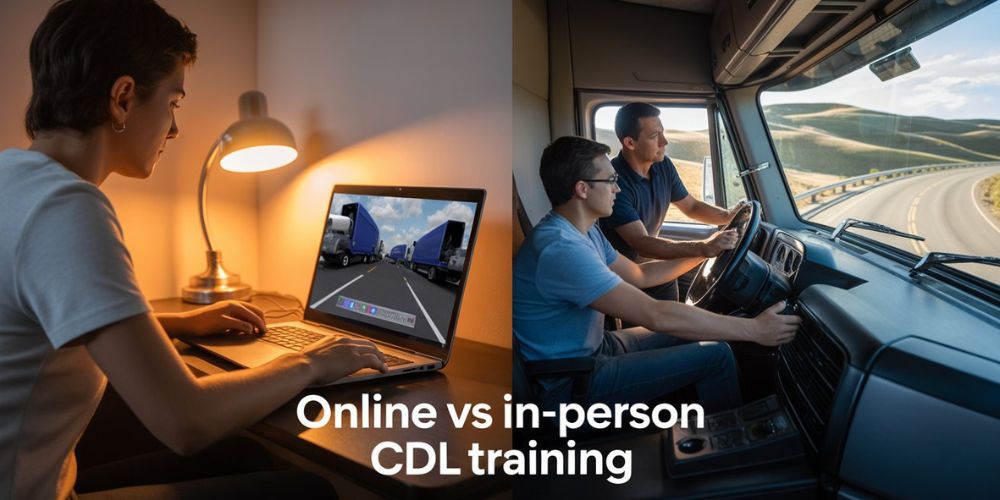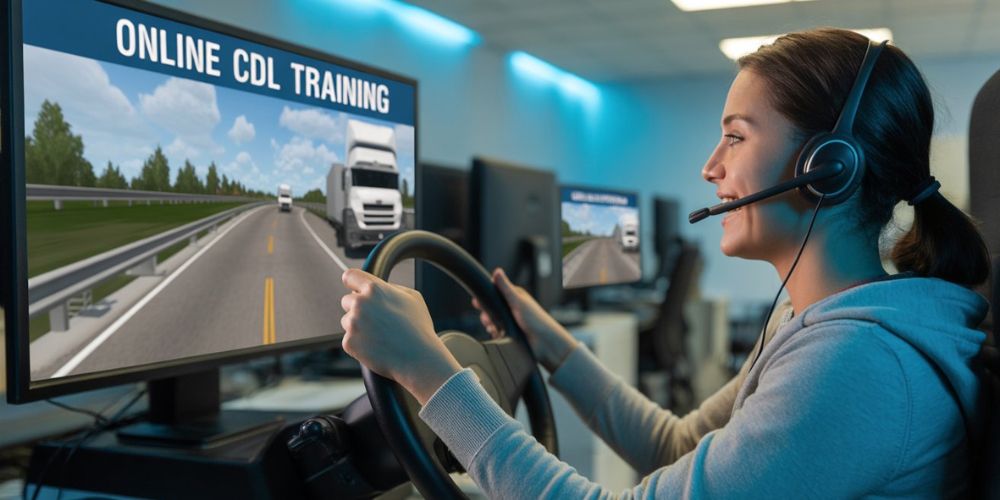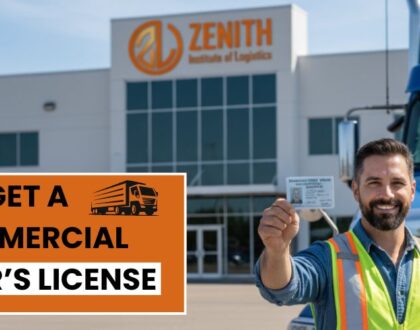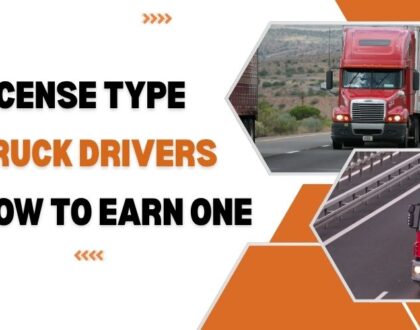Online vs In-Person CDL Training: Pros and Cons

What is CDL?
A Commercial Driver’s License (CDL) is a specialized license that allows individuals to operate large, heavy, or hazardous vehicles such as tractor-trailers, buses, or tankers. To earn a CDL, applicants must pass written knowledge exams and a skills test that includes vehicle inspection, basic control, and on-road driving.
CDL training programs prepare students for both the knowledge portion and the hands-on driving test. They also teach safety standards, federal regulations, and endorsements like Hazmat or passenger transport. Choosing the right training method is critical, and today’s drivers can pick between online CDL training and in-person CDL training. Each has unique strengths and weaknesses.
Online CDL Training

What is Online CDL Training?
Online CDL training delivers the classroom portion of the program digitally. Students access lessons, practice tests, videos, and interactive modules from home or on the go. These courses typically focus on preparing learners for the written knowledge exam. While online platforms cover regulations, vehicle operation theory, and safety, the actual driving portion must still be completed at a certified testing facility or through a hybrid program.
Pros of Online CDL Training
- Flexibility: Learn at your own pace and on your own schedule, ideal for people balancing work or family.
- Convenience: No travel required; all coursework is accessible via computer or mobile device.
- Cost-Effective: Tuition is often lower, and you save on commuting and lodging expenses.
- Self-Paced Learning: Progress quickly if you grasp material fast, or slow down if you need more time.
- Access to Resources: Many platforms provide practice exams, videos, and quizzes that can be reviewed anytime.
Cons of Online CDL Training
- Lack of Hands-On Practice: Driving cannot be learned virtually; you still need in-person training.
- Limited Instructor Interaction: Questions may take longer to answer compared to face-to-face support.
- Self-Discipline Needed: Requires motivation to stay on track without fixed class schedules.
- Technology Barriers: Stable internet and digital literacy are required.
- Employer Perception: Some employers prefer candidates from traditional CDL schools with direct training.
In-Person CDL Training

What is In-Person CDL Training?
In-person CDL training takes place at a physical driving school. It combines classroom instruction with hands-on practice in real trucks. Students work directly with instructors, practice pre-trip inspections, backing maneuvers, and on-road driving. This format is the traditional approach and remains the most widely recognized by employers.
Pros of In-Person CDL Training
- Hands-On Learning: Direct practice with vehicles builds real confidence and skill.
- Immediate Feedback: Instructors correct mistakes on the spot, improving learning outcomes.
- Structured Schedule: Regular class times provide accountability and routine.
- Peer Support: Training alongside classmates creates opportunities to learn collaboratively.
- Industry Recognition: Employers often value graduates from established, in-person CDL schools.
Cons of In-Person CDL Training
- Higher Costs: Tuition, fuel, lodging, and commuting add to expenses.
- Less Flexibility: Students must stick to fixed schedules, which may conflict with work or family commitments.
- Geographical Limitations: Not everyone lives near a quality CDL training center.
- One-Size Pace: Training moves at the group’s speed, which may be too fast for some or too slow for others.
- Time Investment: Daily classes and travel require more time compared to online modules.
Online vs In-Person CDL Training: Key Differences
| Aspect | Online CDL Training | In-Person CDL Training |
|---|---|---|
| Format | Digital lessons, quizzes, and practice tests | Classroom sessions + hands-on truck driving |
| Flexibility | High; self-paced study at home | Low; fixed schedule at a physical location |
| Cost | Generally lower | Higher due to tuition, fuel, and facility use |
| Driving Practice | Not included; must be arranged separately | Included as part of training |
| Instructor Access | Limited to online support | Direct, face-to-face guidance |
| Peer Interaction | Minimal | Strong classmates and group learning |
| Employer Preference | May vary depending on program credibility | Widely accepted and recognized |
Tips for Choosing the Right CDL Training
- Assess Your Learning Style: If you prefer hands-on practice and guidance, in-person may suit you better. If you are disciplined and tech-savvy, online programs may be effective.
- Check Accreditation: Only choose state-approved programs that meet Department of Transportation (DOT) standards.
- Consider a Hybrid Model: Many schools now blend online theory with in-person driving practice, offering a balance of flexibility and experience.
- Budget Wisely: Compare tuition, commuting, and lodging costs. Sometimes the cheaper option upfront isn’t the best long-term investment.
- Look at Job Placement Rates: Established schools often partner with trucking companies to help graduates find employment quickly.
- Plan for Endorsements: If you want Hazmat, tanker, or passenger endorsements, confirm the program covers these areas.
Conclusion
Both online and in-person CDL training have their advantages. Online training offers flexibility and affordability, making it ideal for students with busy schedules. In-person training provides valuable driving practice and direct instructor support, which is crucial for building confidence behind the wheel.
The best choice depends on your personal circumstances. Some students succeed with online coursework followed by in-person practice, while others prefer the traditional classroom route from the start.
No matter which option you choose, the goal is the same: earning your CDL and starting a rewarding career in trucking. At Zenith Logistics Institute, we are committed to preparing drivers with the right skills, knowledge, and confidence to thrive on the road.
Recommended Posts

How to Get a Commercial Driver’s License?
October 30, 2025

Do You Need a CDL to Drive a Straight Truck?
April 30, 2025


